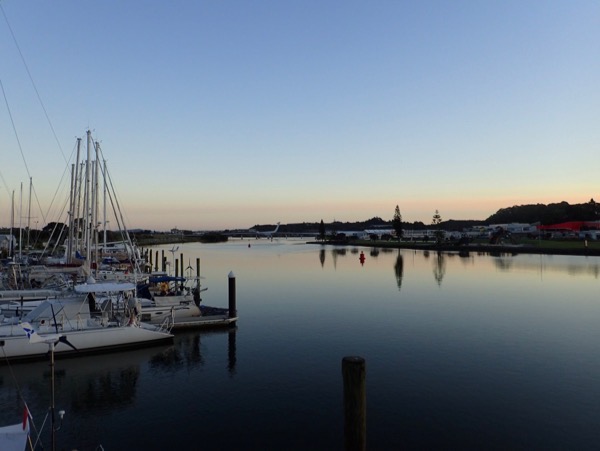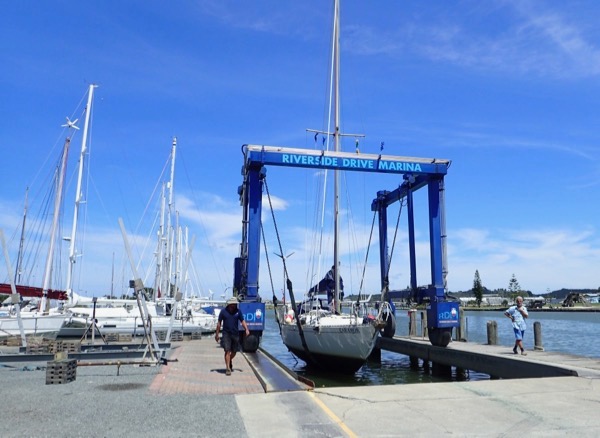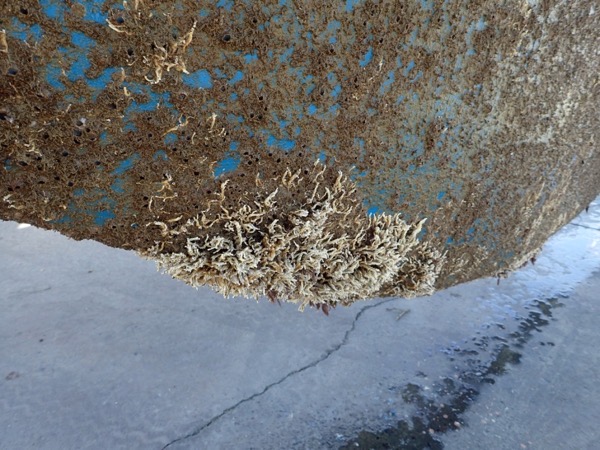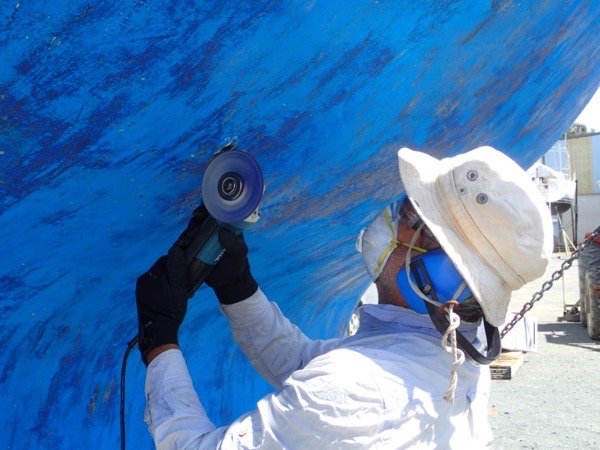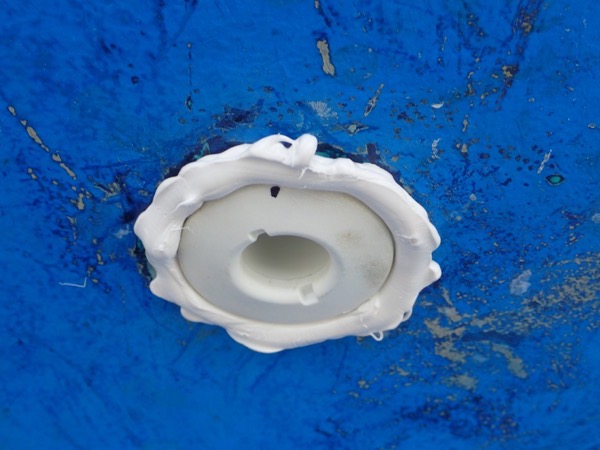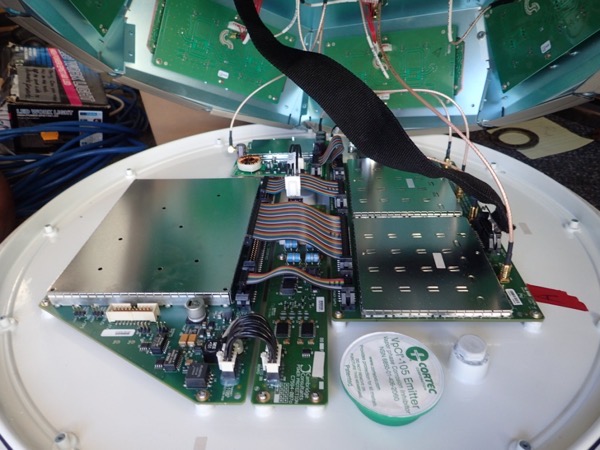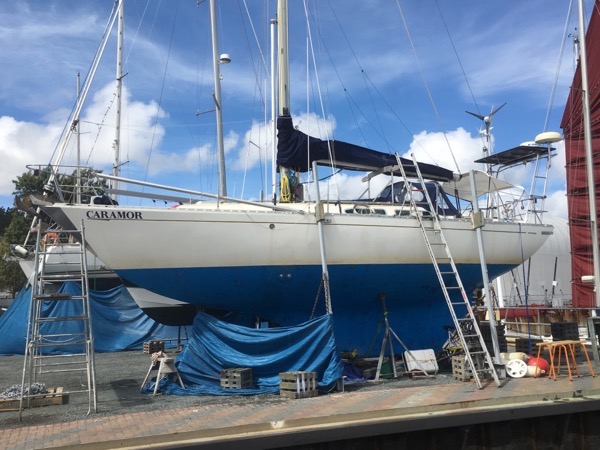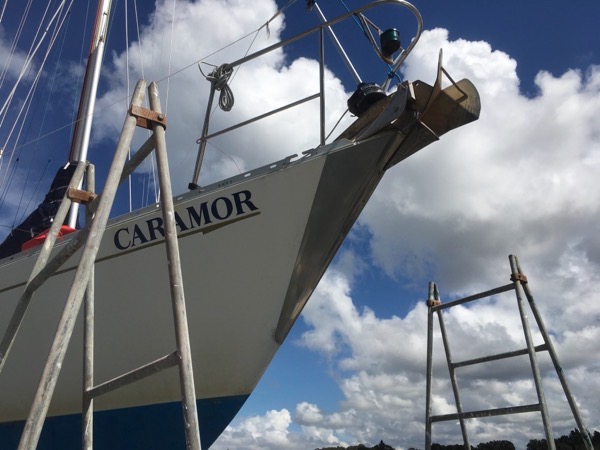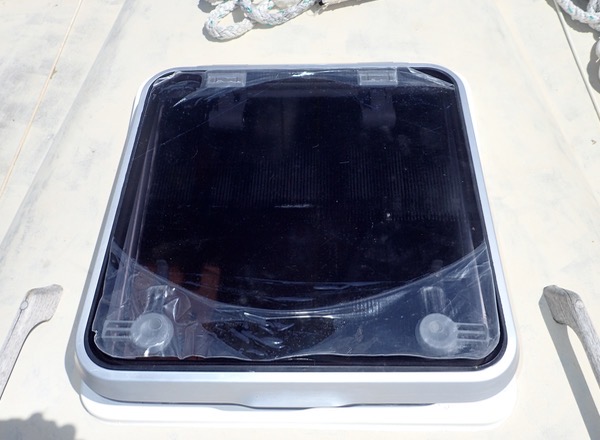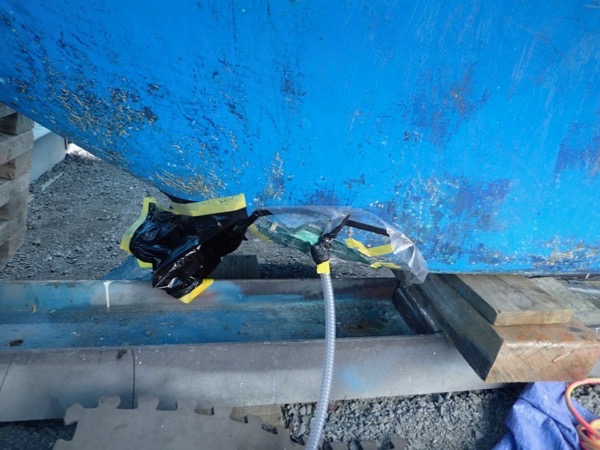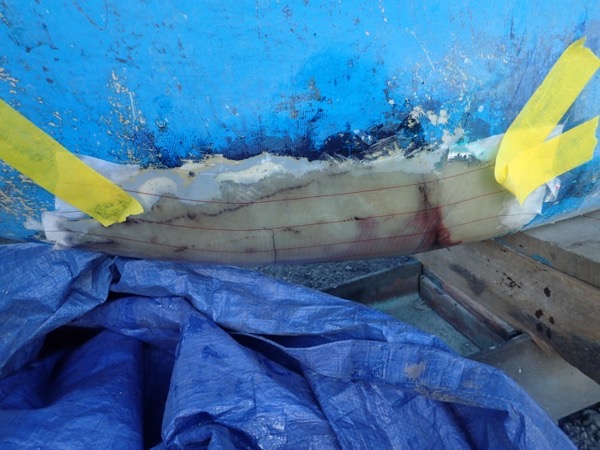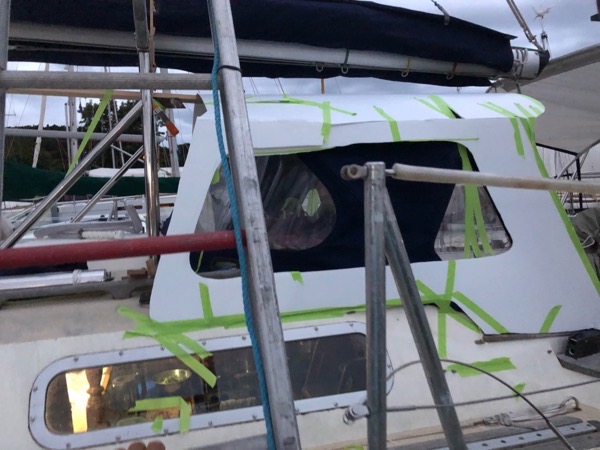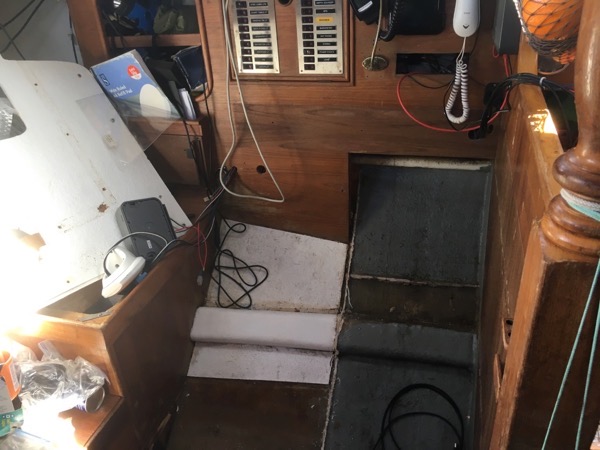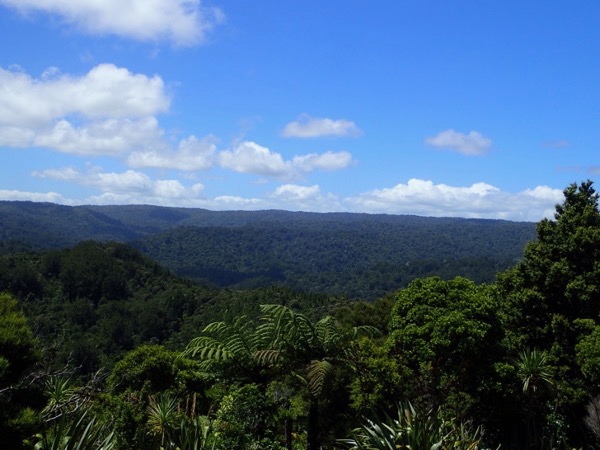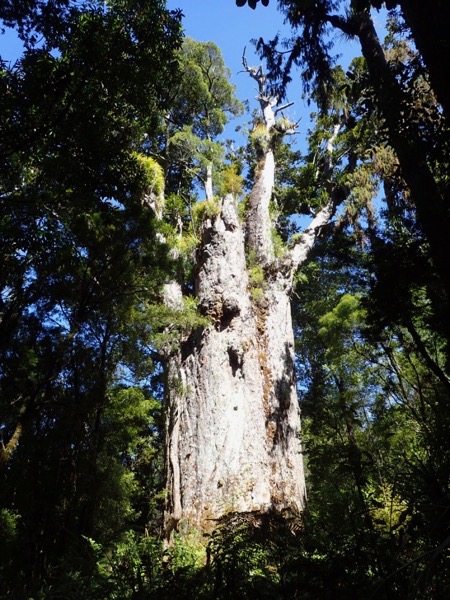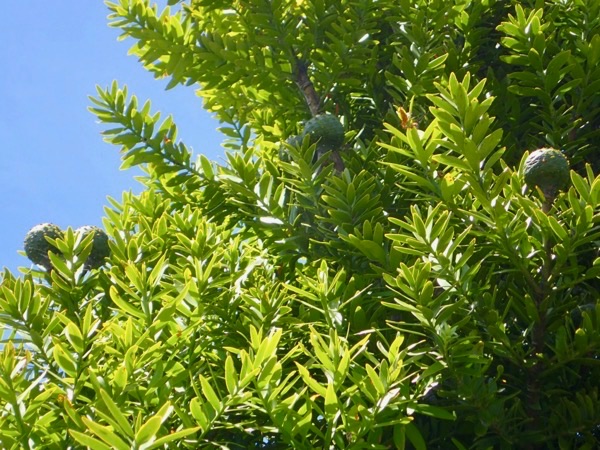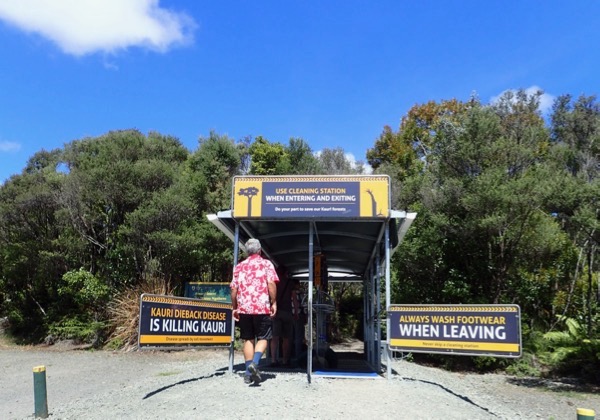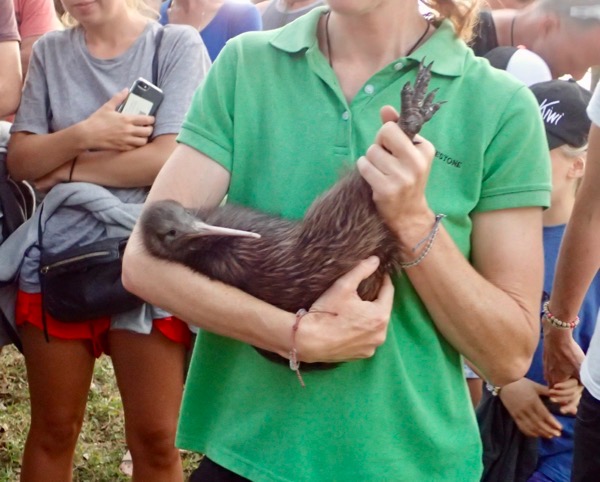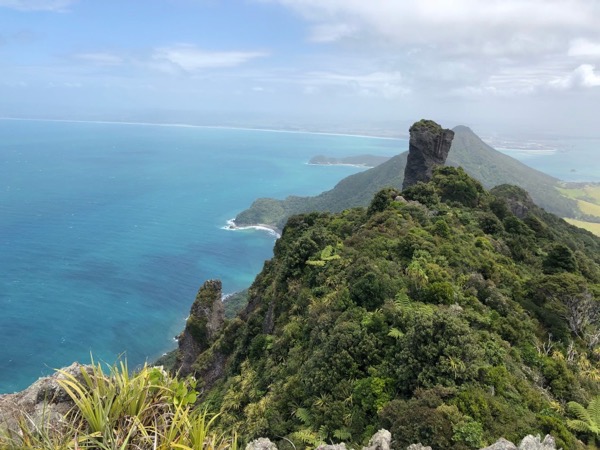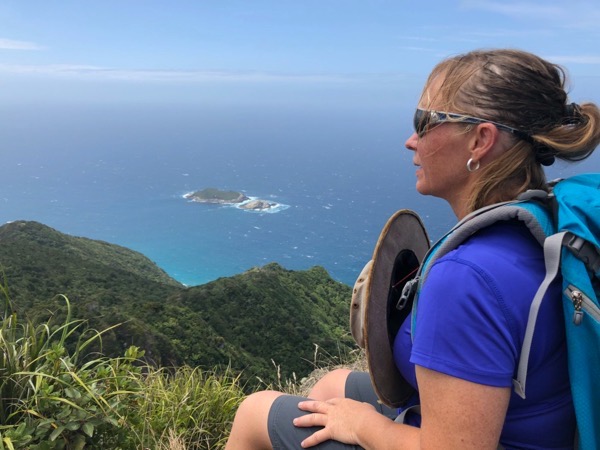Caramor in Whangarei

The days are drawing in and sometimes, like this morning, the Hatea River is shrouded in autumnal mist. Still, on most days the temperature reaches 28 Celsius, a sticky, clammy heat.
Hatea River from Riverside Drive Marina We have been back in Whangarei since 17 January and (literally) busting our backs working on Caramor.
She too had been busy while we toured South Island - growing a whole eco-system on her keel!
Caramor’s keel, it was spotless when we arrived in New Zealand Franco immediately got to work replacing all the sea cocks and skin fittings. Several of the handles were rusty and we didn’t really know how old they were. Instead of bronze, the new fittings are made out of a hard plastic, a lot safer than bronze as they won’t suffer from galvanic corrosion (a major reason for boats sinking). Unfortunately there wasn’t room for the plastic fittings on the toilet seacocks, so we have used a heavy duty very traditional bronze design.
Franco cutting out the old sea cocks
One of the new plastic fittings Whangarei is every boat’s dream - you want it, you can get it. The workmanship is excellent but, of course, quality comes at a price and it is easy to spend a lot of money. Over the years we have been adding bits and pieces to the push-pit, at the back of the boat and now that we wanted a radar and a large solar panel to replace the defunct ones on the coachroof, it was time to take stock. We decided that the way forward was a purpose built arch. Here at Riverside Drive Marina is Terry and his team. The company is called Alloy Stainless &Marine and they were just the people we needed. Terry came over and measured up and soon Nick was working on our new arch. We took down the satellite phone dish so that we could mount it on its new bracket. Much to Franco’s horror, the bottom paint was badly blistered and it looked like the corrosion had gone right through the metal. Satellite communication is essential for Pesda Press to continue functioning when we are out at sea, but the cost of a new dish was astronomical and a second-hand one was barely any cheaper. We decided to try and repair the one we had. Simon, an excellent painter that is often working in the yard, told us that he could repaint it but that first we needed to take it apart. Courageously, we started dismantling it. At the heart of the machine, the circuit boards had been screwed onto the frame and soldered over. Re-doing all those delicate connections was a job I didn’t fancy so we stopped there.
Inside the phone dish The great news was that the inside was pristine, not a hint of moisture and that the paint blister was just the paint and a bit of surface corrosion, the metal below was sound. Simon wouldn’t be able to respray it but Franco could patch it up well enough to last for years.
Phone dish repainted
Caramor’s new arch (note: no rudder and operating curtains) The new arch looks wonderful and (strangely) makes the back deck feel less cluttered. While fitting it, we realised that the push-pit was held in by only two bolts and a few self-tapping screws. We decided to refit it but this time with all through-deck bolts. Balancing Caramor is one of Franco’s constant preoccupations and although the large satellite phone pole has gone, the new arch structure is probably a bit heavier. The solution we came up with was to add a shiny stainless steel bow plate! (More bling for Caramor - while I go around in rags!) The reality is that it was a cheaper way than paint of hiding the wear and tear damage to her bow, and it will protect the gel coat if the anchor swings wildly.
Caramor’s shiny new bow plate To match, Franco ordered a ‘prod’, though I prefer to call it a ‘bowsprit’. This will serve to fly a brand new Code 0 lightweight reaching sail that we have just ordered. Bryan (a friend of Phil and Lynda’s) helped us with the design and recommended Craig of Willis Sails for the sail. This is part of a long time plan not to renew our very heavy main genoa when it wears out.
In the forepeak, I ripped the foam matting off the wall. We’d used it to add insulation in the far south but it made our bedroom dark and dingy.
The forepeak looking in need of tlc We decided to line the front wall with cork and paint it white like the walls. Two of the bed boards were rotten, now replaced and varnished. Franco has added a slide and bulkhead so the surplus anchor chain now has its own compartment. Of course, as soon as the work was finished, we’ve used the space for storage, so a photo will have to wait. The old futon has gone and I will be ordering new cushions for our bunk on Monday. Maybe I’m getting old but I decided to invest in a latex foam topper which we are using in Jumbo at the moment. So comfortable! Such luxury! Although old and crazed, our hatches (‘Velux’ windows) were in reasonable condition. The only thing we needed to change were the hinge pins. Impossible, Lewmar no longer make that model. A hatch coming off at sea could easily lead to disaster so Franco took the expensive decision to replace them. At least when we look up now, the stars we see are real ones, not just the cracking in the glass!
New hatch - now I have to make hatch protectors There is work to do outside as well. Caramor has suffered from an old injury ever since we have known her. Franco attempted a repair but it didn’t last, then in Uruguay we found a fibreglass ace who patched it but in Tonga, we realised that this had come off. It was time to to get it right once and for all so we recruited Glenn who knows a thing or two about fibreglass. He attached a vacuum to the seeping wound and sucked the moisture out with a pump. Caramor looked like she was in the emergency room, wearing an oxygen mask. At last she was bone dry and Glenn patched her up neatly.
In the emergency room
Patched up Franco has had concerns about the guardrails for a few months, particularly as one of the stanchions was very wobbly. It turns out the bolt hole was drilled in the wrong place (by the manufacturers!). Franco has now repaired the deck, re-drilled it and replaced three stanchion bases, two stanchions (we could still order the parts from the UK) and the wires which were made up by Jerry, the rigger at Northsands Boatyard. Angie came to visit, it was nice to see her again and hear about her great trip around New Zealand. We made her work for her stay. She polished up the propellor and did a fantastic job restoring the ship’s clock and barometer that had become badly sea water stained. In her spare time she painted the forepeak. Together we cycled up to Abbey Caves where we marvelled at the glow worms. The propellor has since been serviced, greased and coated in ‘Propspeed’ which will hopefully keep the barnacles off. Franco has removed Caramor's huge rudder and is painting it. It looks rather like a Maori fish hook. As if working on Caramor isn’t enough, we have also both been editing Pesda Press books. We also applied for an American visa which involved lengthy form filling and an overnight dash down to Auckland for an interview. We were successful and now have a multiple entry visa to the USA valid ten years. More about our plans in a future post. From past experience, we have learnt that all work and no play can be counterproductive and that we do need to take the odd day off, otherwise we just end up exhausted and running out of steam. Not too far away, at Sandy Bay, there is a fun and friendly surf beach and we have been keeping an eye on the surf forecast. So far we have managed to go surfing on a couple of occasions and Franco is making great progress. On the Pacific crossing we thoroughly enjoyed the scuba diving and snorkelling. The dilemma was whether to invest in diving gear. While considering our options, we signed up for a Level 2 free diving course in Auckland. It was over a long week-end and out of the six participants, Franco and I were the only ones that achieved the award. We learnt breath holding techniques as well as how to move through the water more efficiently. To pass we had to swim 40m underwater, hold our breath for over two minutes and dive to 16m as well as demonstrate the ability to rescue each other and good finning technique. Ever since The Big Blue, Luc Besson’s iconic film in 1988, I’ve dreamt of diving deep without breathing apparatus. The deep blue of the ocean, the light filtering through the waves, the peacefulness and silence, the colourful fish made a strong impression on my teenage imagination. In Auckland we met at the Olympic swimming pool for our first two sessions. Nearby are some very nice beaches, but no, instead we went to Lake Pupuke or as Franco and I call it ‘Lake Poo-Puke’ - this was the BIG BROWN. Visibility was 0 until you got down to 8m, then the temperature dropped and the sediment cleared but it was pitch black. Down and down we went, following the line, until we could see the torch in the drum we had to touch. We made the most of trip to Auckland to get the bikes and lifejackets serviced, buy a whole load of materials for Caramor’s refit and visit my friend and former colleague Jon and his wife Sharon. Although we were delighted with our improved free diving skills, two and half minutes isn’t a long time underwater to explore a world so different, so we dropped in at Auckland Scuba where Nick gave us excellent advice and we bought a full set of scuba diving equipment. Nearby at Airtec we ordered an air compressor. The only place on Caramor where the (smallest in the world) air compressor would fit was in the saloon, instead of the table. We would have to make a new table to fit over it. A week later, we took all the kit up to beautiful Taiharuru Bay and walked from the car park with all the gear on, into the sea. Getting our weights sorted took a little time but when we did finally manage to sink, we were impressed at the number of fish just off the beach. One lone individual from the grouper family took rather a shine to us and spent a whole minute staring into my mask. He then adopted us and followed us back to shore. We were horrified by the poor visibility caused by sand in suspension. Although much better than Lake Pupuke, diving without visibility was a new experience and we had to be careful not to lose each other. The following Sunday we joined Auckland Scuba’s boat for a dive at the Poor Knights Islands, an offshore nature reserve, rated as a one of the top dive sites in the world by Jack Cousteau. We buddied up with Pete who was on his own. It turned out he’s a published underwater photographer, and was happy to introduce us to the more timid creatures of the deep. We saw so much thanks to him. By the cave grey stingrays circled all around us and vast shoals of blue mau-mau (a large silver-blue fish with large metallic blue spots) got on with their lives. Nick explained that a few years ago there were even more stingrays but that an orca came through and cleared them out, it is taking time for them to return. We invited Steve, a new friend who is a whizz boat designer, over for dinner. He is helping us design a hard top for Caramor which we will build next year. “You want to put the compressor under the table? Are you crazy?” So Franco has spent the week-end with Steve, making a watertight box for the compressor to live up on deck behind of the mast. Although Franco likes a clear deck, this is a great location and will make filling the dive bottles much easier than having to haul the machine out through the companionway every time we want to use it.
Mock-up of the hard top Early on we made the ‘mistake’ of asking Steve for advice about the fridge. It uses a lot of electricity as it is badly insulated. “I’d move it over there,” he said, pointing at the chart table. “Away from the cooker.” Although radical, it is a good suggestion and on Friday I finished demolishing the chart table. Part of me is sorry to see it go but we no longer use full size charts as it is impossible to have all the ones we need, instead we rely more on electronic charts. In its place we will have two Engel chest fridges which are well insulated and use very little electricity (at least, that is what everyone tells us).
Where the chart table used to be Northland is famous for its kauri trees so one Saturday we hit the road in Jumbo and headed for Dargaville and up the west coast to Waipu Forest. The large kauri trees were truly impressive. Te Matua Ngahere is the second largest tree and a whole eco system lives in its trunk.
Waipu Forest
Te Matua Ngahere - the father of the forest. Girth: 16.41m
Kauri up close
Franco approaching a disinfection station to help avoid spreading kauri die-back After weeks looking for kiwi on South Island, it turns out that brown kiwi are right in our backyard. A local organisation ‘Backyard Kiwi’ occasionally organises public kiwi releases. We went along to one. Clearly for the individual kiwis, having 500 people staring at them must be a little daunting but the level of public awareness that these events generate more than compensates. Dogs are the main killers of kiwi. Kiwis are nocturnal. The female lays two huge eggs a few weeks apart and the male incubates the eggs. As soon as the chick hatches, it is independent and the parents leave it to fend for itself. This strategy wasn’t a problem in a mammal-free New Zealand but it has been a recipe for extinction since man and the predators he introduced, arrived. The Backyard Kiwi ranger radio tracks the males and as soon as their behaviour changes after nesting, he goes in, kidnaps the chicks (Dad doesn't care), and takes them to Limestone Island, just off the coast where there are fewer predators (and no dogs). For a year the chicks roam free growing stronger everyday until it is time to return to the mainland. By now they can see off cats, stoats, weasels, rats and even small polecats. The strategy is working and the brown kiwi population is going from strength to strength.
Brown kiwi
The Woodland where the kiwis were released
On Caramor we still have a huge amount of work to do but slowly projects are coming together. At the moment she still looks a mess.
Waterfall near Whangarei
Bream Head, looking towards Whangarei
Ocean Beach (good surfing) from Bream Head
Kath at Bream Head |
